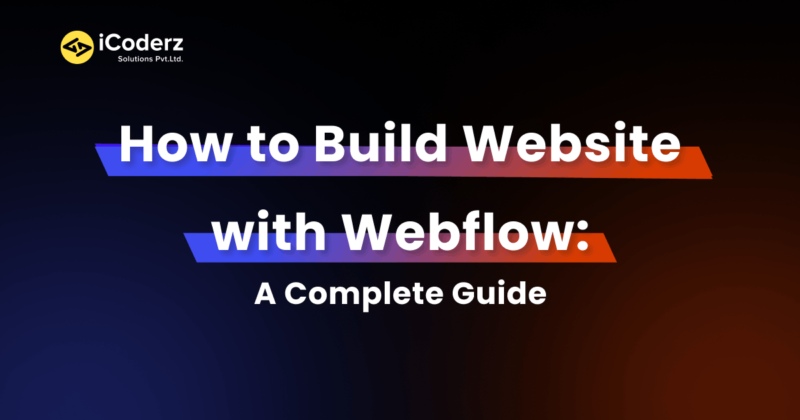Table of Contents
- What is Webflow?
- Essential Features of Webflow for Building Stunning Websites
- Discovering the Hidden Benefits of Webflow for Your Business Growth
- Requirements for Getting Started with Webflow
- Step-by-Step Guide on How to Build Website with Webflow
- How Much Does it Cost to Create a Website with Webflow?
- Finding the Right Webflow Alternative for Your Business
- Frequently Asked Questions ( FAQ’s )
- Conclusion
Creating a website is no small feat – it involves many different components, from design to development and hosting. But with Webflow, you can quickly and easily create a fully functional website in just minutes! In this article, we’ll look at the step-by-step process for How to Build website with Webflow, plus an overview of the cost involved.
What is Webflow?
Webflow is a cloud-based platform that enables you to create responsive websites without having to write code. It’s an all-in-one platform that gives you everything you need to design, build, and launch a website.
With Webflow, you can create a website in minutes without having to learn to code. You can also use Webflow to create web apps and prototypes. Webflow is used by over 1 million people, including designers, developers, and marketers.
Essential Features of Webflow for Building Stunning Websites
Webflow is a powerful website builder that offers a range of features to help you design and publish a professional-looking website. Here are some of the main features of Webflow:
- Drag-and-drop interface: Webflow’s drag-and-drop interface allows you to create custom designs for your website without any coding knowledge.
- Content Management System (CMS): Webflow’s CMS allows you to create and manage content for your website, including blog posts, product descriptions, and images.
- SEO-friendly: Webflow is designed to be SEO-friendly, with features like customizable meta descriptions, alt tags for images, and clean code that helps search engines understand your website’s content.
- Custom Code: Webflow allows you to add custom code to your website, giving you greater control over the design and functionality of your website.
- Collaboration Tools: Webflow offers collaboration tools that allow multiple team members to work on the same website project.
- Integration with Other Tools: Webflow integrates with a range of other tools and platforms, such as Google Analytics, Zapier, and Mailchimp, making it easier to manage and promote your website.
Discovering the Hidden Benefits of Webflow for Your Business Growth
- No Coding Required: Webflow is a no-code website builder, which means you don’t need to have any coding knowledge to use it. This makes it an accessible platform for beginners.
- Customizable Templates: Webflow offers a range of customizable templates that you can use as a starting point for your website design. This can save you time and effort in the design process.
- Design Flexibility: Webflow allows you to create custom designs for your website using a drag-and-drop interface. This gives you greater flexibility and control over the look and feel of your website.
- Responsive Design: All Webflow templates are designed to be responsive, meaning they will look good on any device. This can save you time and effort in creating multiple versions of your website for different devices.
- SEO-friendly: Webflow is designed to be SEO-friendly, with features like customizable meta descriptions, alt tags for images, and clean code that helps search engines understand your website’s content.
- Web Hosting Included: Webflow provides web hosting for your website, which means you don’t need to find a separate hosting provider. This can save you time and effort in setting up your website.
- CMS Capabilities: Webflow offers a content management system (CMS) that allows you to create and manage content for your website. This can be useful if you have a large or complex website with lots of content.
- E-commerce Capabilities: Webflow offers e-commerce capabilities, allowing you to create an online store and sell products directly from your website.
ALSO READ: Webflow VS Traditional Web Development
Requirements for Getting Started with Webflow
Webflow is a powerful web development platform that enables users to create responsive websites without having to write code. In this guide, we will show you how to get started with Webflow and create a simple website.
To get started with Webflow, you will need a paid account. You can sign up for a free trial to test out the features and see if it’s right for you. Once you have an account, you can begin creating your first project.
When creating a new project in Webflow, you will be prompted to choose a template. There are many different types of templates available, so choose one that best suits your needs. Once you have selected a template, you can start customizing it to fit your specific requirements.
Webflow provides an intuitive drag-and-drop interface that makes it easy to add and edit elements on your website. You can also use the built-in code editor to add custom CSS or JavaScript if needed.
Once you have designed and built your website, you can publish it with just a few clicks. Webflow offers both hosting and domain services, so you can get your website online quickly and easily.

Step-by-Step Guide on How to Build Website with Webflow
Creating a website with Webflow is a straightforward process, and it can be done in just a few steps. Webflow is a no-code website builder that allows you to create professional-looking websites without the need for any technical knowledge.
Here’s a step-by-step guide to creating a website with Webflow:
- Sign up for a Webflow Account: The first step is to sign up for a Webflow account. You can sign up for a free account, which allows you to create up to two projects. Alternatively, you can sign up for a paid account, which offers more features and unlimited projects.
- Choose a Template: Webflow offers a range of templates to choose from, or you can start from scratch. Choose a template that suits your needs, and then customize it to fit your brand.
- Customize your Template: Once you have chosen a template, you can customize it to your liking. This includes changing the colours, fonts, images, and layout of the website. You can use Webflow’s drag-and-drop interface to make changes, and you can preview your changes in real time.
- Add Content: Once you have customized your template, it’s time to add content to your website. This includes text, images, videos, and other media. You can use Webflow’s content management system to add and organize your content.
- Set up your Pages: Webflow allows you to set up different pages for your website, such as a homepage, about page, and contact page. You can use Webflow’s page editor to create and customize these pages.
- Publish your Website: Once you are happy with your website, you can publish it on the web. Webflow provides hosting for your website, so you don’t need to worry about finding a separate hosting provider. You can also set up a custom domain name for your website.
How Much Does it Cost to Create a Website with Webflow?
Webflow offers a few different pricing plans, depending on your needs. Here’s an overview of the plans:
1. Basic Plan:
- Perfect for freelancers or individuals who need a simple website
- Includes up to 100 pages and 25,000 monthly visits
- Limited e-commerce functionality
- Pricing: $12/month when paid annually, or $15/month when paid monthly
2. CMS Plan:
- Designed for businesses or organizations that need to manage content regularly
- Includes all Basic Plan features, plus CMS functionality for blog posts, collections, and dynamic content
- Unlimited pages and 100,000 monthly visits
- Pricing: $16/month when paid annually, or $20/month when paid monthly
3. E-commerce Plan:
- Best for online stores and e-commerce businesses
- Includes all CMS Plan features, plus advanced e-commerce functionality like cart and checkout customization, product variants, and customer accounts
- Unlimited pages, unlimited monthly visits, and unlimited products
- Pricing: $42/month when paid annually, or $50/month when paid monthly
4. Business Plan:
- Ideal for businesses or agencies with larger teams and more complex website needs
- Includes all CMS Plan features, plus team functionality, white-labeling, and priority support
- Unlimited pages, unlimited monthly visits, and advanced e-commerce
- Pricing: $36/month per site when paid annually, or $45/month per site when paid monthly
5. Enterprise Plan:
- Best for large businesses, organizations, or agencies with complex needs and custom solutions
- Includes all Business Plan features, plus personalized onboarding, dedicated account management, custom integrations, and tailored SLAs
- Custom pricing based on specific needs and requirements. Contact Webflow for more information.
6. Average Costing
The total average cost for developing a Webflow site can vary widely depending on a number of factors, such as the complexity of the design, the features and functionality required, and the experience level of the developer.
Here are some general estimates for the different stages of creating a Webflow site:
- Design: Depending on the design complexity and the level of customization required, the cost of designing a Webflow site can range from $500 to $5,000 or more.
- Development: The cost of developing a Webflow site can vary depending on the level of customization required, the complexity of the site’s functionality, and the experience of the developer. A basic Webflow site can cost around $1,000 to $5,000, while a more complex site with advanced features and custom functionality can cost upwards of $10,000 or more.
- Content Creation: The cost of creating high-quality content for a Webflow site, such as copywriting, photography, and video production, can range from $500 to $5,000 or more depending on the scope and complexity of the project.
- Maintenance: Ongoing maintenance of a Webflow site can include tasks such as updates, backups, and security checks and may cost around $100 to $500 per month.
Overall, the total cost of a Webflow Development site can range from a few thousand dollars to tens of thousands of dollars depending on the scope and complexity of the project. It’s important to work with an experienced Webflow developer who can provide an accurate estimate based on your specific needs and requirements.

Finding the Right Webflow Alternative for Your Business
1. Wix
There are a few alternatives to Webflow that are worth considering. These include:
Wix is a popular website builder that offers a drag-and-drop interface and a wide range of templates. It’s free to use, but you’ll need to upgrade to a paid plan to remove Wix branding from your site.
2. Weebly
Weebly is another popular website builder that offers an easy-to-use drag-and-drop interface. It has a wide range of templates and includes features such as contact forms and e-commerce integration. Weebly is free to use, but you’ll need to upgrade to a paid plan to remove branding from your site.
WordPress is a well-liked platform for managing content that has the capability of being utilized for the creation of various kinds of websites. While it can be tricky to set up, there are plenty of resources available online to help you get started. WordPress is free to use, but you’ll need to pay for hosting and a domain name. You can also find paid themes and plugins to add more functionality to your site.
Frequently Asked Questions ( FAQ’s )
Here are four frequently asked questions (FAQs) about creating a website with Webflow:
1. How much does Webflow cost?
Ans: Webflow offers a range of pricing plans, starting at $12 per month for the Basic plan and going up to $36 per month for the Pro plan. There is also an Enterprise plan available for large businesses that need more advanced features. Opting for an annual payment is also a viable option to avail a price reduction.
2. Do I need coding knowledge to use Webflow?
Ans: No, you don’t need any coding knowledge to use Webflow. The platform is designed to be a no-code website builder, which means you can create custom designs for your website using a drag-and-drop interface. However, if you do have coding knowledge, you can add custom code to your website for greater control and flexibility.
3. Is Webflow a good choice for e-commerce websites?
Ans: Yes, Webflow offers e-commerce capabilities that allow you to create an online store and sell products directly from your website. You can use the platform’s e-commerce features to add products, manage inventory, process payments, and more.
4. How long does it take to create a website with Webflow?
Ans: The time it takes to create a website with Webflow will depend on a range of factors, such as the complexity of your design, the amount of content you need to add, and the features you want to include. However, with the help of Webflow’s customizable templates and drag-and-drop interface, you can create a website relatively quickly compared to coding a website from scratch.
Conclusion
In conclusion, Websites are essential for any business to thrive in a digital world. Creating a website with Webflow is an easy and cost-effective way to get started without needing coding knowledge beforehand. With this step-by-step guide, you can create your beautiful website in no time. The pricing structure of Webflow also offers flexibility and affordability that allows you to choose the best plan depending on your requirements. So if you’re ready to take your business online, why not give Webflow a try?





